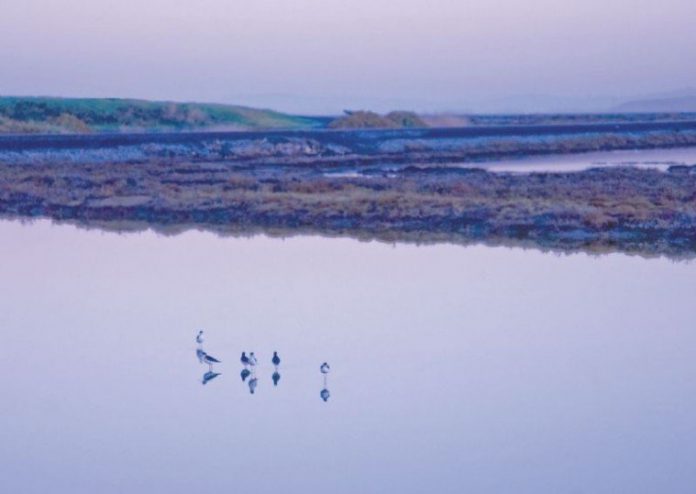It’s fall, and birds are on the move. I know very little about
shorebirds, but, early one morning, I decided to pack up my
binoculars, my copy of
”
The Sibley Field Guide to Birds
”
and my ignorance (which I always carry with me) and head to
Alviso Marina County Park.
It’s fall, and birds are on the move. I know very little about shorebirds, but, early one morning, I decided to pack up my binoculars, my copy of “The Sibley Field Guide to Birds” and my ignorance (which I always carry with me) and head to Alviso Marina County Park.
Up early, I drove north on U.S. Highway 101 in the morning’s gathering light just before sunrise.
On any clear morning or evening, just before sunrise or after sunset, the sky above the horizon opposite the sun’s location will have a shadow line – a soft, warm shade of pink above and a cool, dark purple below. That beautiful line is the Earth’s shadow reflected off atmospheric haze.
This morning, it seemed particularly brilliant as I watched it descend in the western sky.
Last week, I wrote about the Woods Trail on the flank of Mount Umunhum, where Guadalupe Creek first trickles to life. Here, in Alviso, the Guadalupe River lazily eases into San Francisco Bay and ends its journey. And what an intriguing community!
Early Californians settled Alviso in the 1700s. It thrived as a key port linking San Jose and San Francisco during the Gold Rush. Now, it has the quaint appearance of a quiet, historic delta town waiting to be cute-ified into another Carmel.
Alviso Marina Park is one of several parks, preserves and refuges along the bottom of the bay that together protect the entire estuary as habitat for shorebirds, ducks and other birds that migrate through or reside there. The park itself is a 19-acre former marina that has been restored to a marshland of grasses and rushes, but it also is a gateway to the 22,350-acre Don Edwards San Francisco Bay National Wildlife Refuge.
The portion of the refuge I walked, like most of the bayland areas I have seen, is a series of trails along levees and dams that take you among the ponds, sloughs and various waterways where birds reside. I saw many black-necked stilts walking delicately along the shallow mudflats. In flight, they were just as elegant with their long red legs trailing behind. Their sharp, single-syllable call was the predominate bird chatter rising from the ponds. I was able to identify American avocets, dowitchers, a flashy northern shoveler and lots of sandpipers walking the mudflats and floating further from shore.
While I enjoyed watching and identifying the variety of birds, the real joy of being there was standing back and watching the new day develop. As sunlight broke, I felt enveloped in a tranquil calm. The pond water was so perfectly still that the wading birds appeared to walk through a sheet of cool glass that perfectly reflected the steely blue and pink predawn skylight. Later, as the day warmed, several large tightly bunched flocks of sandpipers took flight at once. They moved in perfect unison, quickly altering direction this way and that; each group criss-crossing the others in a free-form pattern over the water. In the process, hundreds of bright bellies suddenly flared white, then, with a quick change of direction, disappeared just as another flock lit up as they shot in a different direction. The rapid flashing light show had the effect of a holiday fireworks display.
Whether or not you are a birder, you will enjoy walking along the frontage of the San Francisco Bay.
For maximum enjoyment on your visit, I recommend bringing three tools: binoculars, a field guide and a copy of “Birding at the Bottom of the Bay,” written by the Santa Clara Valley Audubon Society. You’ll be surprised by what you see and learn. If you come at daybreak, you’ll receive a big dose of magic.











